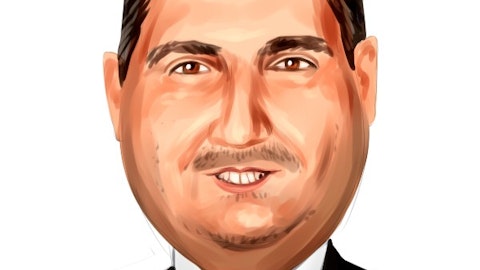Josh Raskin: Thank you.
Operator: Thank you, Mr. Raskin. Our next question comes from Mr. Nathan Rich with Goldman Sachs. You may ask your question.
Nathan Rich: Great. Good morning, and thanks for the questions. I wanted to go back to biosimilars. How has the pricing of biosimilar of Humira compared to expectations as more competition come to market? And given what appears to be a very significant reduction in pricing, does that pull forward the benefit from the Humira biosimilar at all? And for the different options that you added to the formulary, should we think of the economics of each of those as being similar to Evernorth? And then, just a quick follow-up on the Cigna Healthcare segment. Brian, could you maybe help us think through the seasonality this year and maybe why that’s different than a typical year? And as we think about the 2024 and going forward, do you go back to more normal seasonality in that business? Thank you.
Eric Palmer: Good morning, Nathan. It’s Eric. I’ll start. So, as you noted and implied in your question, biosimilars are a really important opportunity to drive competition and for us to then help to make that competition efficient to drive improvements to the affordability of these high-cost specialty medicines. Now, in 2023, we’ve continued to co-prefer Humira on the formulary. Towards the beginning of the year, we added Amjevita to our National Preferred Formulary and recently added Cyltezo and Sandoz’s products, both the low and high [indiscernible] versions onto the NPF. So that’s the activity that’s gotten us to this point to date. I would note, we work through with the manufacturers on the terms of those to drive to the best available cost, the best available expense for our clients.
And we have visibility into that pretty early on. So, we’ve navigated and made our arrangements in constructing the placement such as we came into this year. And so, I wouldn’t want you to think about there being dynamics kind of playing out simultaneously. These are things we have negotiated in advance. We have visibility into as the products come into the market and we work to leverage the competition to continue to improve affordability for the benefit of the clients we serve. Over time, as we drive even more products, more competition, we’ll work to continue to bring improved levels of affordability to our clients and continue to construct our offerings in a way that best meet their needs. I hand it over to Brian on the second part of your question.
Brian Evanko: Good morning, Nathan. It’s Brian. So, as it relates to the Cigna Healthcare seasonality, I’d start — just to remind you, we expect the second half earnings to be a little bit less than 55% in the third quarter. Relative to the MCR component of that, our prior expectations on the MCR seasonality have not changed. So, what I mean by that is the directional pattern we saw, for example, in 2022 on MCR is a reasonable proxy for what we’d expect the 2023 quarterly pattern to be, and as a result, the fourth quarter MCR is likely to be the highest quarter of the year as we see more customers meet their deductible and out-of-pocket maximum obligations. However, we do expect the pace of SG&A spending to look different than it did last year.
For example, we had a step up in SG&A in the fourth quarter of 2022 that we would not expect to recur in the fourth quarter of ’23. The other item that I call your attention to is our net investment income in the fourth quarter of ’22 was considerably weaker than what we’re expecting to see in the fourth quarter of ’23. So, those are the primary things to think through as it relates to the seasonality pattern. As it relates to ’24. At this point in time, there’s nothing I’d call your attention to that will lead us to think there’s any abnormal pattern.
Operator: Thank you, Mr. Rich. Our next question comes from Mr. Steven Valiquette. Your line is open. You may ask your question.
Steven Valiquette: Great. Thanks. Good morning. So, I guess to the extent that your Medicare Advantage book is seeing a more normalized utilization trend this year that you baked into your pricing and guidance, just curious if you have any additional color just for the second quarter and whether it normalized more in the outpatient setting versus inpatient. I just want to hear a little more color on some of the trends by cost category, just given how topical this is for the industry this quarter. Thanks.
Brian Evanko: Good morning, Steve. It’s Brian. So, as you noted, we planned and priced for more normalized utilization levels in 2023, and our claims experience is largely consistent with that expectation. So, within the MA book specifically to the core of your question, we have seen elevated utilization of both outpatient and professional services all year. But important this should be viewed in the context of what we had forecasted and priced for. So, the overall cost trends are largely in line with our expectations in both our second half 2023 guidance and our 2024 bids. Anticipate that, that dynamic will continue, as it relates to specifically within outpatient and professional surgeries are the area that I’d call your attention to, in particular, orthopedic and cardiovascular, we did see some level of favorability in inpatients.
So those are a few of the subcategories that I’d call your attention to, but all in line with what we had anticipated coming into the year.
Steven Valiquette: Okay. That’s perfect. Thanks.
Operator: Thank you, Mr. Valiquette. Our next question comes from Mr. Stephen Baxter with Wells Fargo. You may ask your question.
Stephen Baxter: Yeah, hi, thanks. I wanted to ask about some of the moving parts in the P&L this year for Evernorth. In the first half, there’s a pretty notable divergence in the growth of revenue and gross profit. And then, what you’ve seen dropped through to earnings. I know that Centene is a big part of that and the investments you’re making there. But the trend underneath that still feels like it’s pretty notable. Any additional color on what’s going on within Evernorth SG&A would be helpful. Whether that’s investments or mix or anything else that we should be keeping in mind? Thanks.





